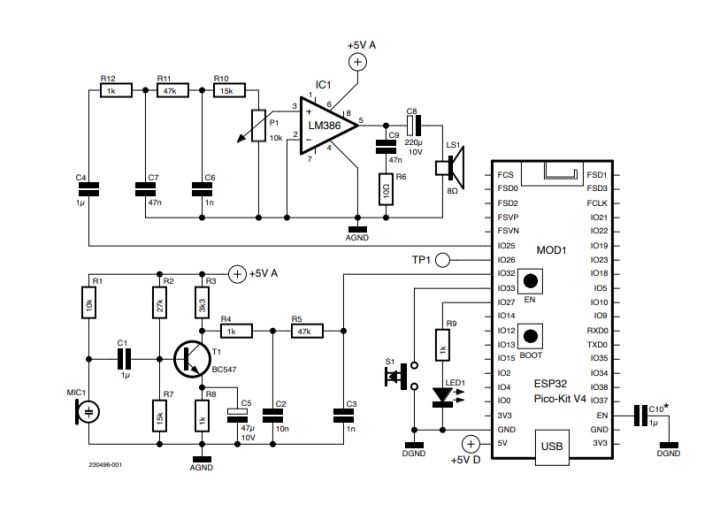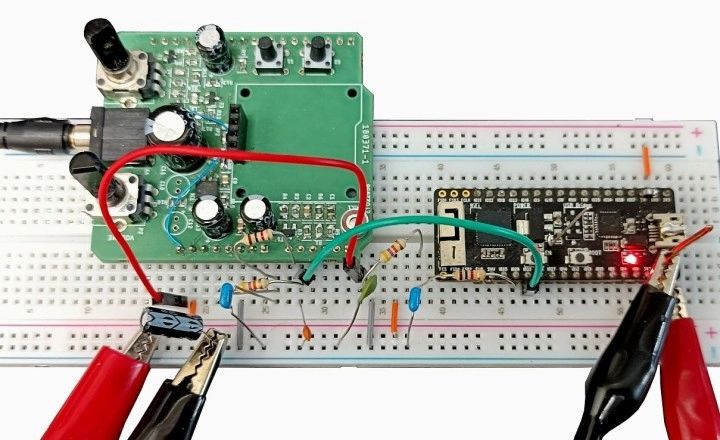In a recent article in Elektor magazine, [Clemens Valens] describes the construction and software for an ESP32 walkie-talkie system that uses ESP-NOW for the wireless connection between units, along with a low-cost condenser microphone with a transistor-based preamplifier and an LM386 op-amp for the speaker circuit. In the ESP32 module the built-in DAC and ADC are used for audio in and output, which provide just about enough resolution for voice communication.
So why use ESP-NOW rather than WiFi or Bluetooth? Mostly because of range, power usage and convenience with no SSIDs and passwords to bother with.

ESP-NOW is Espressif’s own network protocol that uses the same underlying hardware as 2.4 GHz WiFi and Bluetooth, but focuses on more basic direct and mesh-style communication. It can be considered to be somewhat like low-level UDP with MAC address instead of IP address, which makes it useful for fire-and-forget traffic such as from IoT devices.
In the past, we’ve seen ESP-NOW control everything from fake security cameras to CNC machines. In fact, we’ve even seen it used in another walkie-talkie a couple years back.

















Does anyone know if there is a NOT DIY Version of this? Just a “real” walkie-talkie she’ll with a hackable ESP32 and battery inside?
Lilygo T-TWR?
Absolutely not : Lilygo T-TWR is an analog radio.
I mean, what would the appeal be for that as a finished device rather than a “real” real walkie-talkie? Or if you were to make something like that, what about anything fast enough to encode and decode the freeDV codecs in real time?
At ESP-NOW data rates you don’t need freeDV, just do 24k OPUS or even 48k if you’re on WiFi.
The appeal over a real walkie talkie is that FRS radios aren’t that great for sound quality, and they don’t have mesh networking, and there’s not enough channels. Plus there’s no location sharing or anything fancy like that on most affordable ones.
They’re good enough though, so I’ve just kind of accepted that FRS is what people use even if it’s a bit disappointing. I really wish the FCC would open some more spectrum in the same range and allow digital voice.
Yeah, if you use something with this sort of bitrate you might as well use one of those codecs, but I think it would be nice to have more range rather than a high bitrate.
That said, you can get pretty good quality on FRS if your radios aren’t crappy, which most of them are. The same FM parameters normally provide a clean, very readable voice with other (e.g. amateur) radios. Even the cheap chinese ones you’d expect to be worse. Maybe the handhelds made for GMRS would be better? Or MURS. And especially the latter two can easily go miles if done right. Or maybe there’s at least one FRS handheld that has actually improved over what we had 10-20 years ago, but that’s probably too much to ask.
I have seen Dickie branded 2.4ghz toy walkie talkies. Idk what chip they use tho
MMDVM ham modem
Was curious to see how it actually sounds. Lack of videos are disappointing.
It doesn’t sound like anything, as they aren’t transferring audio they’re just blinking an LED at a distance.
So the microphone and speaker in it are completely non-functional?
I’m pretty disappointed with ESP-NOW range. (I mean 15 meters indoor), just saying.
And WOOH I just wrote after Bill Gates.
ESP-NOW in long range mode can do around 500m
Actually this is pretty interesting. Radio communications technology celebrates one hundred years since Marconi’s first radio transmission entertainment broadcast into the world. Just when you thought there was nothing new under the sun after a hundred years we get this. Thank you.
I have been contemplating doing this with the Codec 2 voice codec. Unfortunatly, the ESP 32 doesn’t have a FPU so it is a bit complicated. And then again, my coding skills are not up to snuff…
https://en.wikipedia.org/wiki/Codec_2